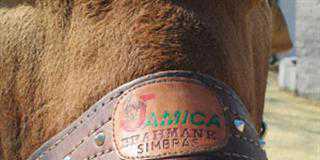Recent events confirm that livestock and dairy farmers are unable to produce feed for their animals in times of drought and have to resort to buying expensive feed. This puts some farmers under such financial pressure that they are often forced to sell their cattle and even give up dairy farming altogether. Now a new feed growing system promises to make any farm “drought-proof”.
Vivian Beukes of Bioboost Solutions in George, Western Cape, developed the Bioboost feeding system to sprout, or germinate grain and legume seed for highly nutritious, cost-effective livestock feed. A cost comparison done by the company shows that feeding cattle barley from the Bioboost feeding system instead of barley feed grain can save a farmer R5/animal/day that amounts to R1 825/head/year.
No extras
A unit is 8,1m long, 3,4m wide and 2,7m high, and is covered by special plastic sheeting to allow the optimal amount of sunlight. Each unit takes 196 trays, with aeroponic technology used for the growing. “Unlike hydroponics, where plants are grown with their roots in a mineral nutrient solution, aeroponics has no growth medium and no nutrients are given to the plant,” explains Vivian.
Grown in specially designed sprouting trays, the sprouts use nutrients from seeds in the form of starch that is converted to plant sugars. No fertiliser or chemical is used to help grow the sprouts, only clean water via an overhead mist irrigation system. The sprouts are harvested after seven to eight days, when most of the nutrients in the seed have been used.
“Each day you remove the feed that’s ready from the trays, rinse the tray, reseed and put the tray back into the unit,” says Vivian. “Feed quality barley germinates within 24 hours of seeding. The barley grows in the same tray for six to eight days and is then ready for harvest as a grass mat. “This ‘sprout mat’ is highly nutritious as it’s a living food. The animals will eat the entire mat, so there’s no waste.”
Soaking the seeds
Before being placed in the growing trays, the seed must be soaked in water for about three hours. This helps the seed to better absorb water when irrigated. It also helps speed up the germination process. “We recommend irrigating the seed once an hour for about 40 to 50 seconds in summer and once every two hours for the same duration during winter,” says Vivian.
The system should use about 500â„“ to 800â„“ water per 24-hour cycle. According to Vivian, the system uses the same amount of water per year as a pivot irrigation system for growing grazing and feed on 30ha uses in a day.
Feed
The Bioboost feeding system can produce 600kg to 700kg feed a day to replace silage in the animals’ diet. The silage needed to feed 300 sheep can be replaced with feed grown by just one of these systems, notes Vivian. “If you compare the amount of feed that can be produced using the system with the size of land needed to grow a similar amount of feed, I reckon that if the system functions optimally it could produce the equivalent amount of feed grown on 30ha land under irrigation,” he adds.
Bioboost Solutions recommends farmers use barley seed because of its nutritional benefits. “Barley sprouts from the system are good for the digestive system of the animal, leading to healthier animals,” explains Vivian. Barley sprouts increase the red blood cell count, resulting in more oxygen, which means the animal uses less energy. Nutritionally, adds Vivian, each kilogram of barley sprouts is equivalent to 3kg lucerne.
Costs
The Bioboost feeding system costs R73 750 (excluding VAT and transport), but includes installation. Some 15 units are already in operation across the country. “We do the installation. All the farmer needs is a concrete floor, and a water and power point,” says Vivian. “This system really offers farmers a way to ‘drought-proof’ their farms, and they can also keep more livestock without having to buy or rent more land,” he adds. “Just by being able to keep more animals on a farm already helps increase productivity and profitability, but farmers also save on input costs, because the feed costs less to produce.”
Contact Vivian Beukes on 082 6737211 or e-mail [email protected].
Contact Gawie Willemse on 082 787 5680 or e-mail [email protected].












